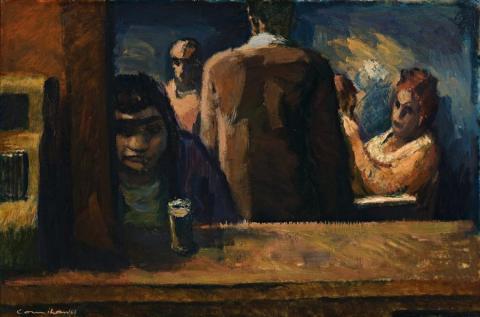A BAR IN FITZROY, 1962-63
Noel Counihan
oil on composition board
61.0 x 92.0 cm
signed and dated lower left: Counihan ’63
artist's label with title and exhibition history attached verso
Macquarie Galleries, Sydney
Private collection
Leonard Joel, Melbourne, 4 April 2000, lot 178
Company collection, Sydney
Noel Counihan, Bonython Art Gallery, Adelaide, 3 – 14 September 1962, cat. 2 as 'A Fitzroy Pub'
Spring Exhibition, Victorian Artists' Society, Melbourne, 9 – 21 September 1963, cat. 37 as 'A Bar in Fitzroy'
Noel Counihan, Paintings and Drawings, Macquarie Galleries, Sydney, 16 – 28 October 1963, cat. 12, as 'A Bar in Fitzroy'
In the early 1960s Noel Counihan's mind was on pubs. In 1962 he exhibited In a Fitzroy Pub in the Victorian Artists' Society's autumn show. His first solo show in Adelaide, in the spring of the same year, included the painting on offer then titled A Fitzroy Pub, and Ladies' Parlor [sic] together with the large Pub Talk. In the 1963 winter and spring exhibitions of the Victorian Artists' Society Counihan showed an ongoing inclination, the painting on offer, somewhat recomposed and repainted, reappearing as A Bar in Fitzroy. If this were not sufficient, he obliged by a repeated showing of several in Sydney, adding Pub Talk, now lent by the Trustees of the Queensland Art Gallery. While miners, wharfies, the unemployed, and the tragic plight of Aboriginal people were subjects dearest to his heart, portraits had begun to make a real presence in his art, as did pub life and culture. In an interview with Clive Turnbull, whose portrait he painted in 1968, Counihan explained - 'My first interest has always been people, and it still is. I find them more interesting in themselves. In human society, the warmth is mainly at the bottom - people there share what they're got, and so you see humanity at its most colourful. But even speaking purely visually, it's the working people that stimulate me. The other day I was having a drink in a pub with another artist. The bar was full of workingmen, and every one of them - whether he was wearing overalls, pullover, stained trousers, no matter what " carried on him the marks of his occupation.'1
Pub Talk 1962, which is the largest of the series, showed a typical male pub scene of three workmen seated with their glasses of beer on the pub table. The language of their bodies expresses the ready engagement of their conversation. Our painting, and probably Ladies Parlor, takes a slightly different path. In the days of Melbourne's six o'clock swill, when drinks had to be downed before the pubs closed, drinking was largely segregated. It was a serious male business, as portrayed by John Brack in The Bar 1954. In After Work 1958 (also National Gallery of Victoria) and all his pub scenes, Counihan combined civilised drinking with mateship. The ladies, however, had their own 'parlour', its isolation flying in the face of boasted egalitarianism. Always the hero of injustice and crusader against stupidity, Counihan's A Bar in Fitzroy brought men and women together with dignity and in conviviality. The shadowed female face at the side, looking across the bar, provided a satiric reminder. Counihan was one of many to challenge the notion that the pub was the man's domain.
1. Turnbull, C., 'Noel Counihan: A Fighter Against Social Injustice', Age, Melbourne, 3 March 1962, p. 18
DAVID THOMAS
